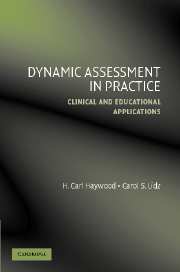Book contents
- Frontmatter
- Contents
- Preface
- Foreword, by Kenneth A. Dodge
- Foreword, by Thomas Oakland
- PART ONE THEORY AND PRINCIPLES
- 1 Dynamic Assessment: Introduction and Review
- 2 A Model of Mental Functioning
- 3 General Procedural Guidelines for Conducting an Assessment That Includes Dynamic Assessment
- PART TWO APPLICATIONS
- APPENDIX A TESTS REFERRED TO IN THE TEXT THAT DO NOT BELONG TO THE AUTHORS
- APPENDIX B SOURCES OF DYNAMIC ASSESSMENT MATERIALS
- References
- Author Index
- Subject Index
- Tests and Testing Materials Index
1 - Dynamic Assessment: Introduction and Review
Published online by Cambridge University Press: 04 December 2009
- Frontmatter
- Contents
- Preface
- Foreword, by Kenneth A. Dodge
- Foreword, by Thomas Oakland
- PART ONE THEORY AND PRINCIPLES
- 1 Dynamic Assessment: Introduction and Review
- 2 A Model of Mental Functioning
- 3 General Procedural Guidelines for Conducting an Assessment That Includes Dynamic Assessment
- PART TWO APPLICATIONS
- APPENDIX A TESTS REFERRED TO IN THE TEXT THAT DO NOT BELONG TO THE AUTHORS
- APPENDIX B SOURCES OF DYNAMIC ASSESSMENT MATERIALS
- References
- Author Index
- Subject Index
- Tests and Testing Materials Index
Summary
DEFINITIONS
Dynamic assessment (DA) is no longer a new approach to psychological and educational assessment; in fact, some of its current applications have been around for more than a half century (see, e.g., Feuerstein, Richelle, & Jeannet, 1953; Guthke & Wingenfeld, 1992). Despite such a relatively long history, it is still not widely practiced around the world (Elliott, 1993; Lidz, 1991, 1992). In April 2005, 588 literature citations relating to dynamic assessment were listed at the Web site www.dynamicassessment.com. The majority of those are of recent date, suggesting a rapid growth of interest in this topic in the last 10 to 15 years. A much broader search engine (www.google.com) produced 17,800,000 hits for this term; to be sure, the overwhelming majority of these did not relate to “dynamic assessment of learning potential.”
At the dynamic assessment Web site, DA is defined as “an interactive approach to conducting assessments within the domains of psychology, speech/language, or education that focuses on the ability of the learner to respond to intervention.” Others have defined it variously, but the constant aspect of the definition is active intervention by examiners and assessment of examinees' response to intervention. Haywood (1992b) suggested that dynamic assessment is a subset of the more generic concept of interactive assessment. He further suggested that “It might be useful to characterize as interactive any approach to psychological or psychoeducational assessment in which the examiner is inserted into an active relationship with a subject and does more than give instructions, pose questions, and record responses.
- Type
- Chapter
- Information
- Dynamic Assessment in PracticeClinical and Educational Applications, pp. 1 - 20Publisher: Cambridge University PressPrint publication year: 2006



